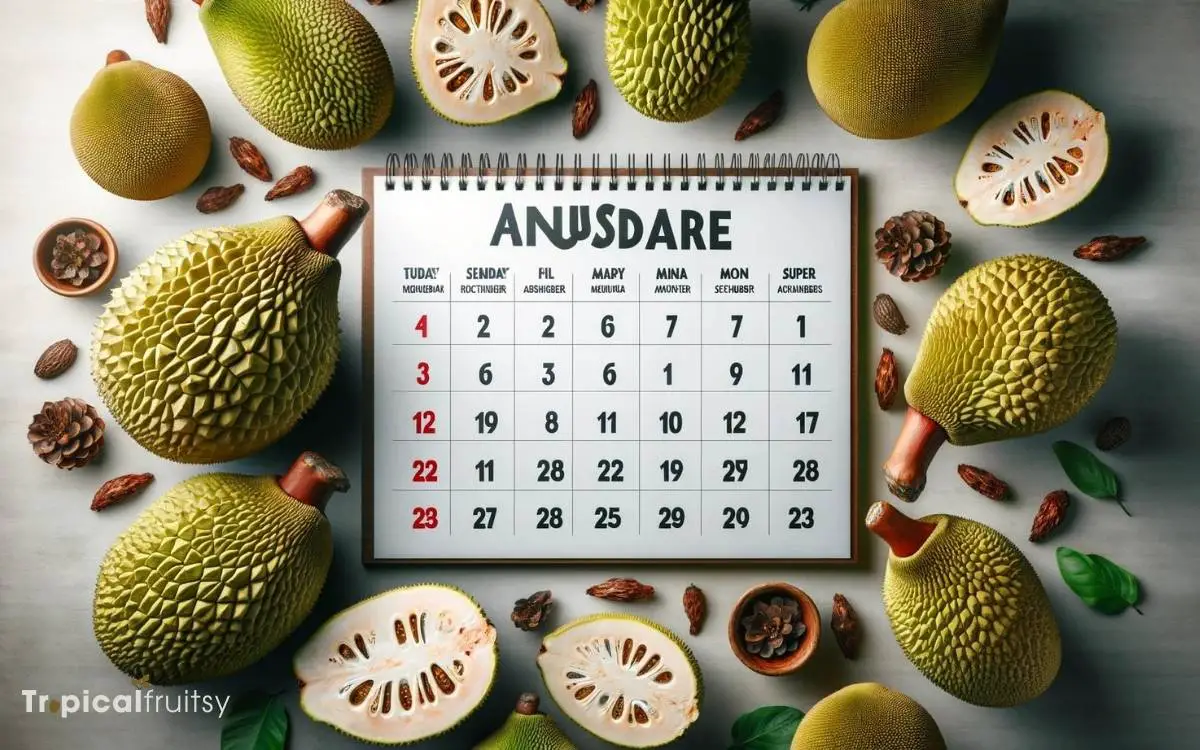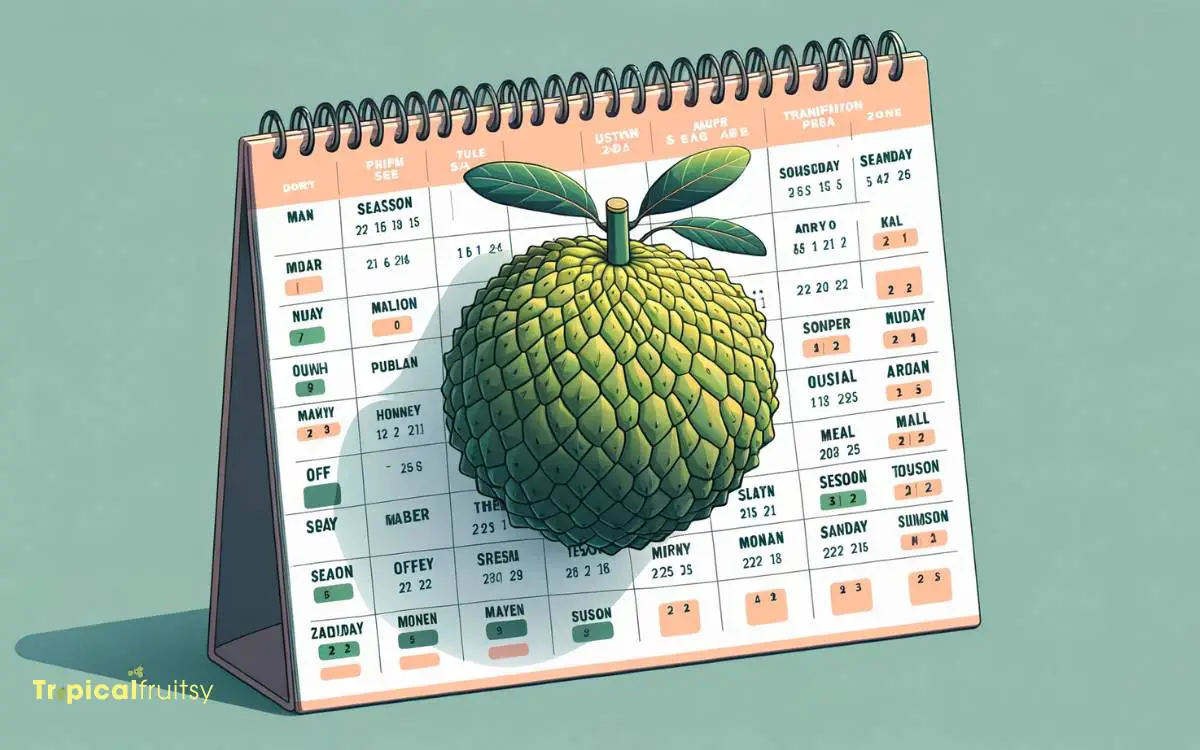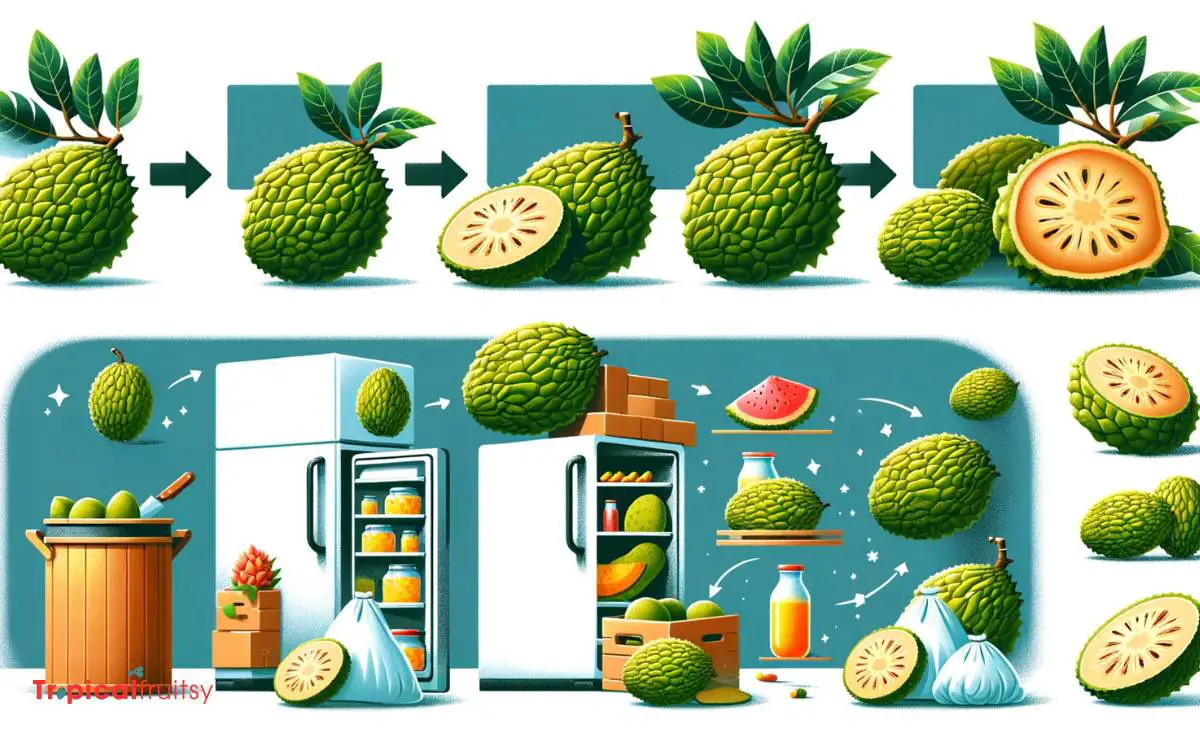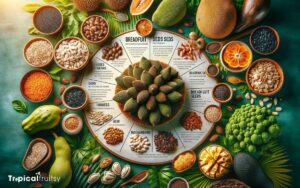When Is Breadfruit in Season? Explained!
Breadfruit season typically peaks from late summer to early winter, but availability can vary by region, with some areas having year-round production.
Breadfruit is a seasonal fruit, with its availability largely dependent on regional climates. Local climate and weather patterns significantly influence breadfruit’s growth cycles and harvest times.
Breadfruit’s seasonality is key for fresh consumption and affects global agricultural schedules.

Key Takeaway
Breadfruit Seasonality Across Regions
| Region | Breadfruit Season Start | Breadfruit Season End | Year-Round Production |
|---|---|---|---|
| Pacific Islands | August | December | No |
| Caribbean | June | February | Some areas |
| Southeast Asia | Varies | Varies | Yes, in some regions |
| South Asia | Varies | Varies | Yes, in some regions |
| Equatorial Regions | Continuous | Continuous | Yes |
Understanding Breadfruit Seasonality

One must recognize that the seasonality of breadfruit varies depending on geographic location and climatic conditions.
In the regions where Artocarpus altilis predominantly thrives—tropical locales such as the Pacific Islands, parts of Southeast Asia, and the Caribbean the fruiting season can be influenced by the interplay of temperature, rainfall, and specific local environmental factors.
Typically, breadfruit trees exhibit a cyclical pattern of productivity, with peak harvests occurring twice a year in some regions, aligning with the wet and dry seasons.
These periods are marked by a significant increase in the maturation and availability of the fruit, which is integral to forecasting yield potentials and managing supply chains.
Accurate prediction of these cycles necessitates detailed phenological studies and climate monitoring to optimize harvest timing and ensure food security.
Global Breadfruit Harvest Times

Breadfruit trees reach their harvest period at varying times around the world, largely dictated by regional climatic conditions. The fruiting cycles are influenced by factors such as rainfall, temperature, and altitude.
Detailed phenological studies and agricultural records help pinpoint optimal harvest times across different geographic locations.
To elucidate the global breadfruit harvest times, consider the following:
- South Pacific Islands: Typically, breadfruit season extends from November to February, coinciding with the wet season.
- Caribbean: The peak harvest occurs twice yearly, from June to July and then from September to October.
- Southeast Asia: Harvest seasons vary, but often align with the monsoon cycles, generally from May to August.
- Hawaii: The main season runs from August to December, influenced by the islands’ microclimates.
These periods are subject to annual variations and may be adjusted for local microclimatic influences.
Regional Variations in Availability

The seasonality of breadfruit is inextricably linked to regional climatic conditions, which influences the timing and volume of its availability.
Variations in latitude, altitude, and local weather patterns can lead to significant disparities in harvest periods between different growing areas.
A detailed analysis of these factors is crucial for understanding the complexities of breadfruit production cycles and the resultant market availability across various regions.
Climate Impact
Several factors, including regional climate variations, significantly influence the availability of breadfruit throughout the year.
These climate impacts can be categorized as follows:
- Temperature: Breadfruit thrives in consistently warm temperatures. Regions with significant temperature fluctuations may experience altered flowering and fruiting cycles, impacting harvest times and yields.
- Precipitation: Adequate rainfall is crucial for breadfruit; however, excessive rain can lead to root rot and other diseases, compromising fruit production.
- Humidity: High humidity levels can foster fungal diseases that affect breadfruit trees, whereas low humidity can cause stress and affect fruit development.
- Storms and Extreme Weather Events: Tropical storms, hurricanes, and droughts can destroy crops or alter the seasonality of breadfruit, leading to unpredictable availability.
These climatic variables require meticulous monitoring to optimize breadfruit cultivation and harvesting schedules.
Harvest Times Differ
As a result of the climatic factors previously discussed, the harvest season for breadfruit varies widely across different geographical regions.
In the Pacific Islands, where breadfruit is indigenous, the primary season typically spans from late summer to early winter, though some cultivars may produce fruit intermittently throughout the year.
Conversely, in the Caribbean, breadfruit season generally peaks from July to December, aligning with the region’s wetter months which facilitate the fruit’s growth cycle.
These regional disparities in harvest times are attributable to variations in rainfall patterns, temperature fluctuations, and relative humidity levels.
Understanding these local climatic conditions is paramount for agricultural planning and maximizing yield, as breadfruit’s sensitivity to environmental changes necessitates precise timing for optimal harvesting.
Climate Impact on Breadfruit Cycles

Breadfruit harvest periods can be significantly influenced by local climate variations, including temperature fluctuations and rainfall patterns. These environmental factors are crucial in determining the fruit’s growth and maturation phases.
A technical analysis of the climatic elements affecting breadfruit cycles reveals:
- Optimal Temperature Range: Breadfruit trees thrive within a specific temperature bracket, with extreme deviations potentially delaying flowering and fruiting stages.
- Rainfall Frequency: Consistent precipitation is vital for breadfruit development, whereas droughts can lead to reduced yields and stunted growth.
- Seasonal Shifts: Unpredictable seasonal changes, possibly due to climate change, can disrupt traditional harvest calendars, necessitating adaptive agricultural strategies.
- Cyclonic Events: Tropical storms and hurricanes can devastate crops, causing complete harvest failures and long-term impacts on breadfruit production cycles.
Understanding these parameters is essential for predicting breadfruit availability and planning for sustainable cultivation amidst changing climatic conditions.
Optimal Months for Fresh Breadfruit

The optimal months for harvesting fresh breadfruit are contingent upon the plant’s phenological patterns, which vary by geographical location and climatic conditions.
Peak harvest times generally align with the late summer and early fall months in the tropics, where breadfruit trees exhibit the highest yield and fruit maturity.
Investigations into seasonal availability variations are critical for ensuring the timely distribution and consumption of this perishable commodity within its prime freshness window.
Peak Harvest Times
Peak harvest times for fresh breadfruit typically occur twice a year, with the primary season spanning from July to October and a secondary, less abundant season from December to February.
These periods are dictated by a combination of environmental factors that influence the fruit’s development cycle.
To better understand these peak times, consider the following:
- Climatic Conditions: Optimal temperature and humidity levels during these months contribute to the fruit’s growth rate and quality.
- Rainfall Patterns: Adequate precipitation is necessary, but excessive rain can impair pollination and fruit set.
- Daylight Hours: Longer days in the primary season promote photosynthesis, enhancing fruit production.
- Agricultural Practices: Timely pruning and fertilization by growers ensure the health of the trees, influencing the seasonal yield.
An analytical understanding of these elements is crucial for anyone interested in breadfruit cultivation or consumption.
Seasonal Availability Variations
Understanding the nuances of breadfruit’s seasonality is key to identifying the optimal months for obtaining the freshest and most flavorful fruits.
Breadfruit trees (Artocarpus altilis) flourish in tropical climates where they have adapted to the wet and dry cycles, causing regional variations in fruiting times.
Typically, the peak availability of breadfruit aligns with the latter part of the wet season and can extend into the dry season, owing to the tree’s response to climatic triggers.
In the Pacific Islands, for instance, the prime season spans from May to September, whereas in the Caribbean, the apex ranges from July to February.
Optimal harvest is contingent upon the intersection of genetic cultivar properties, local weather patterns, and soil conditions, necessitating a precise analysis of these factors for accurate seasonal prediction.
Breadfruit Ripening and Storage

Harvested breadfruit should be allowed to ripen at room temperature until the flesh becomes soft and the skin turns from green to a yellowish color, indicating readiness for consumption or storage.
To ensure optimal ripening and storage conditions, one must consider:
- Ambient Temperature: Maintain a consistent room temperature between 20°C to 25°C to facilitate even ripening.
- Humidity Control: A relative humidity of 75-80% is ideal to prevent dehydration and maintain fruit quality.
- Gas Exchange: Breadfruit emits ethylene as it ripens; therefore, adequate ventilation is necessary to prevent over-accumulation, which can lead to uneven ripening or spoilage.
- Storage Duration: Once ripened, breadfruit can be refrigerated for a short period to extend edibility; however, cold storage should not exceed 3-5 days to avoid chilling injury.
Purchasing Breadfruit Off-Season

During the off-season, consumers looking to purchase breadfruit may need to rely on imported varieties or frozen alternatives to find this tropical fruit.
The market availability of off-season breadfruit is contingent on international supply chains, which are influenced by factors such as export policies, climatic conditions in growing regions, and global demand.
Imported breadfruit often comes from equatorial countries where the fruit can be harvested year-round. However, transportation logistics can impact fruit quality, leading to potential compromises in taste and texture.
Frozen breadfruit offers a more consistent quality and extended shelf life but requires adequate cold chain management to preserve its nutritional and sensory properties.
Consumers should scrutinize the source, check for the integrity of packaging, and verify that the product has been stored at consistent temperatures to ensure optimal quality.
What Are the Best Seasonal Ways to Cook Breadfruit?
When it comes to cooking breadfruit, methods like grilling, roasting, and frying are popular during different seasons. For summer, grilling breadfruit brings out its natural flavors, while in the fall, roasting is a great way to enjoy its hearty taste. And in winter, frying breadfruit makes for a comforting, warm dish.
Future Trends in Breadfruit Cultivation

Breadfruit cultivation’s trajectory is poised to evolve with advances in agricultural technology and increased interest in sustainable crop production.
As researchers and farmers seek to optimize yield and minimize environmental impact, several key trends are emerging:
- Genetic Improvement: The development of new breadfruit varieties through traditional breeding and biotechnology aims to enhance disease resistance, increase shelf-life, and improve nutritional content.
- Precision Agriculture: Utilizing data-driven farming practices to monitor and manage breadfruit trees can lead to more efficient resource use and higher quality produce.
- Climate Adaptation: Breeding for climate resilience and implementing innovative farming methods will be critical as breadfruit-growing regions face changing weather patterns.
- Agroforestry Integration: Incorporating breadfruit into diverse farming systems can bolster ecosystem health, improve soil fertility, and support biodiversity.
These trends reflect a methodical approach to breadfruit cultivation that balances productivity with ecological stewardship.
Conclusion
Breadfruit serves as a vital staple for many tropical regions. It demonstrates distinct seasonality influenced by geographical location and climate conditions. The optimal period for consumption is typically during the latter half of the year.
With advances in agricultural practices, off-season availability may increase, supporting food security.
One striking statistic is that a single breadfruit tree can produce up to 200 fruits per season. This illustrates its potential to significantly address hunger in food-insecure populations.






